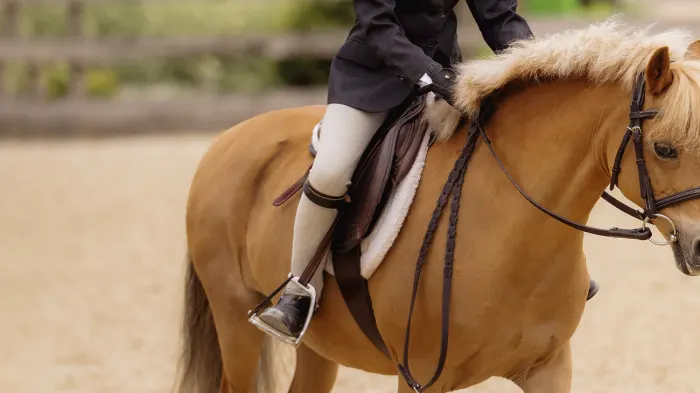To protect its youngest members, the U.S. Equestrian Federation should prohibit rubber band and hooked safety stirrups from being used at recognized competitions. This hook-and-loop design, often called a “peacock stirrup,” has been used for a long time to prevent a fallen rider from getting caught in the stirrup and being dragged. However, these stirrups are dangerous and have caused horrific injuries to children while dismounting.
There is a long history of riders getting caught on the upward-pointing hook part of these safety stirrups while sliding down the saddle to dismount. Some riders have caught their belt or ripped their clothing on the way down. Although it doesn’t look sharp, the hook can rip through clothing, tear into the skin, and cause mutilating injuries to the abdomen, genitals and groin. While all rides do not end in a fall, every ride using these stirrups ends with a dismount that exposes the rider to this risk of serious injury.
I personally have seen two cases when riders, one a boy and one a girl, suffered horrible genital lacerations from a hook-and-loop safety stirrup hook while dismounting at USEF competitions. Both children required major surgery and will have permanent injuries.

Photo by Jump Media LLC
While I have written about this topic in the past through my equestrian law website and on social media, I’m not aware of anything that USEF has considered in terms of a rule change or an official ban. These stirrups are routinely used at USEF competitions by many young riders, which puts children at continued risk. USEF should recognize the risk these stirrups present and protect its members by prohibiting their use at horse shows. A rule banning hook-and-loop safety stirrups should be passed immediately by the USEF Safety Committee, presidential modification, or some other emergency action. There is no excuse for another child being injured by these so-called “safety stirrups” when the situation can be easily prevented.
Safety stirrups are designed to prevent a rider’s foot from getting stuck in the stirrup and therefore preventing injury from being dragged. However, the hook-and-loop design is inherently dangerous, though correcting this faulty design could be as easy as putting the hook on the bottom pointing downward or facing it inward instead of outward.
Other safety stirrups, which do not incorporate a hook attachment, are available on the market and prevent a rider from being dragged without any risk of bodily injury. There are multiple design options available for those who want to replace peacock stirrups with ones that are safer and use a different mechanism to release the foot if caught. These include bent-arm, forward-facing stirrups and those with safe side release mechanisms.
Simply stated, dismounting over a peacock stirrup creates an unacceptable risk of serious bodily injury. The risk of being caught in the stirrup and dragged after a fall can be reduced by wearing proper riding boots with a heel and, more importantly, by using safety stirrups that are actually safe. Another precaution is to make sure the stirrup bar on the saddle is not locked in the “up” position, allowing the stirrup leather to slip off the bar in an emergency.
These unsafe peacock stirrups have been on the market for many years. They are sold by many companies, often made overseas, and any legal recourse against manufacturers for faulty design and damages for injuries is impracticable.
USEF should take action to protect its members from these dangerous hooked stirrups by outlawing their use at competitions. It is as simple as that. Riders are not allowed to ride without proper equipment at competitions because of the risk of injury. Because of the known risk of injury from these peacock stirrups, the USEF’s failure to act could expose it to future litigation.
If you have these peacock stirrups, don’t wait for an injury to happen to your child. Get rid of them and replace your stirrups today.
